Is Chongqing Raffles City just an internet famous building? No, you may have misunderstood. It actually knows Chongqing so well
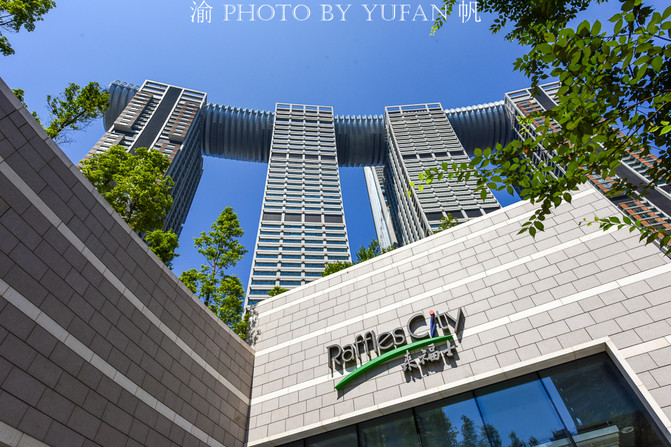
A few days ago, on the way back from Guangdong to Chongqing, a foreign friend asked me: "Where is Chongqing the hottest this year? Where should I go if I can only choose to go to one destination to clock in?" I thought for a while, and then told him, "Go to Raffles! New landmark of Chongqing, zero kilometers of Chongqing, the highest point of Chongqing, the intersection of the two rivers, the Chinese version of the sky garden, the world's longest horizontal skyscraper, and climb onto China's first 250 meter theme viewing platform, overlooking the grand scenery of the two rivers, as well as Monument to the people's Liberation, Jiangbei Mouth, Hongya Cave, marble, Yangtze River cableway, Huguang Hall and many other popular spots on the Internet, to meet your food, There are many demands for living, playing, traveling, shopping and entertainment.
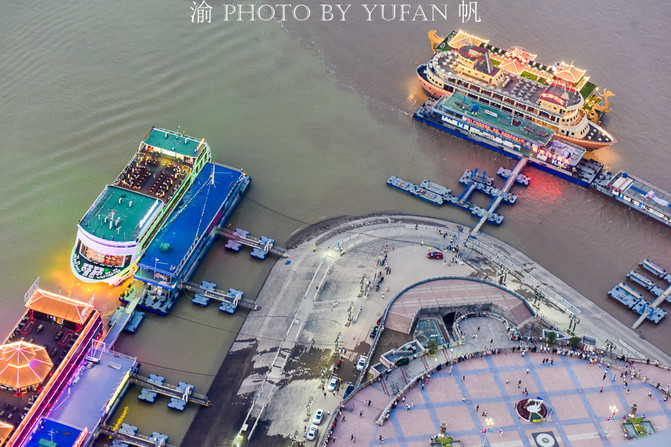
To be honest, I didn't actually come to Fushi at that time. As a Chongqing native who loves my hometown but has been wandering outside for a long time, as well as a senior moderator of Chongqing Forum for 15 years, I always paid attention to the development of Chongqing, especially for iconic projects like Raffles City that have a huge impact. Although this understanding is mostly based on the internet and hearsay, it doesn't prevent me from recommending them to friends in the outside world like a treasure trove.
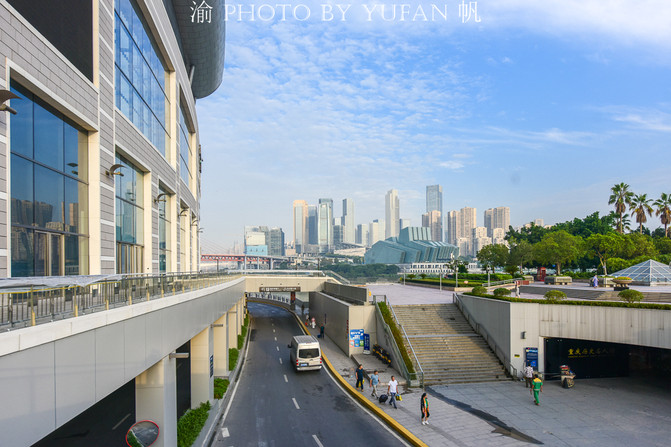
It's always a regret not to have been there. In order to make up for this regret, after returning to Chongqing this time, I specifically visited Raffles City for two days. After two days, Raffles City was still the same city, but its impression in my mind quietly changed. Before that, it was a huge foreign-funded commercial complex in my impression; After playing, I found that it is not only a new landmark building in Chongqing, but also an understanding of Chongqing's history and cultural heritage. I sincerely praise it from the bottom of my heart.

Opening the scroll of history, "Leaves float and sink in Bazi Kingdom, Shuangjiang collar carries Futu Pass". When King Wu of Zhou led the Ba people to defeat Zhou, he enfeoffed Ji's son "Ba" as Ba Kingdom and moved the capital to Jiangzhou, marking the beginning of the construction of Chongqing. Later, Qin conquered Ba Kingdom and stationed troops under the guidance of Zhang Yi from Guiguzi, marking the first large-scale construction of the city in Chongqing. At that time, land transportation was underdeveloped, and the location of Chaotianmen was the most important port for entering and leaving Jiangzhou (Chongqing). Afterwards, Li Yan of the Three Kingdoms criticized Zhang Yi for building too small a city, so he began to expand it; In the Song Dynasty, Emperor Guangzong of Song first conferred the title of Prince Gong and later ascended to the throne in Gongzhou, proclaiming himself a "double celebration". As a result, Gongzhou was elevated to Chongqing Prefecture, elevating its status and expanding its city; In the fourth year of the Hongwu reign of the Ming Dynasty, Chongqing Commander Dai Ding once again built a large number of city walls and "nine openings and eight closures" totaling 17 city gates, including the Cuiwei, Dongshui, Tai'an, Taiping, Renhe, Chuqi, Jinzi, Fenghuang, and Nanji city gates along the Yangtze River, the Jintang, Tongyuan, and Dingyuan city gates connecting the land routes, and the Linjiang, Hongya, Qiansi, and Xishui city gates adjacent to the Jialing River. The largest city gate is Chaotian Gate.
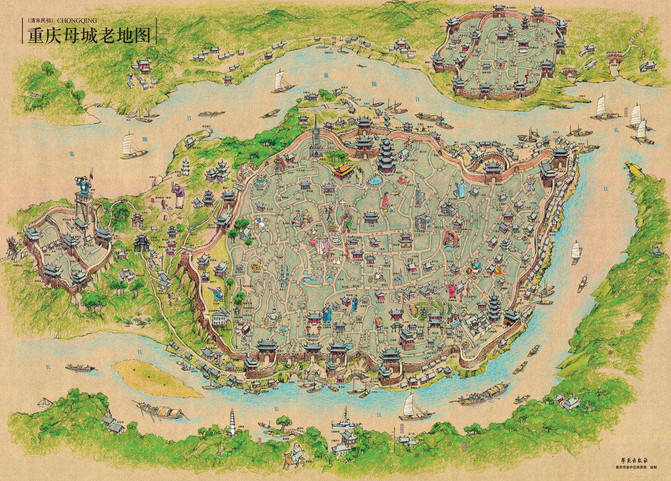
As the main city gate for welcoming officials and saints, Chaotianmen has always been the geographical and spiritual center of Chongqing. However, with the development of the city and the upgrading of people's consumption awareness and habits, the living circle of Chongqing people has begun to change. Due to the limitations of industrial form and transportation, Chaotianmen has become a place where local people rarely go. Until the construction of Chongqing Raffles City, its landmark buildings, large-scale commercial areas, and diversified recreational facilities have effectively turned this trend around, attracting local people of different ages and tourists from other places back to Yuzhong Mother City and Chaotianmen, making them the consumption and living centers of urban people, and thus better inheriting the historical memory of Chaotianmen.
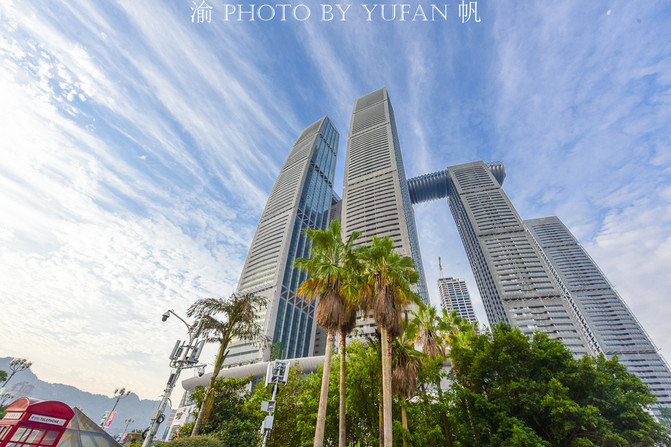
In terms of design, internationally renowned design master Moses Safdi has visited and studied the history of Chaotian Gate multiple times. By utilizing the terrain of the Yuzhong Peninsula, which is like a giant ship, he ingeniously designed the shape of Fushi as a soaring sail. Not only does it match the shape of the Yuzhong Peninsula on the side, but the 235000 square meter commercial building at the bottom of the podium also serves as a stable base for the sail. Moses Safdi hopes that through this building, people can awaken their imagination of the huge mast and sail, and feel the power of the wind and the rhythm of the water flow. In Yufan's view, it is not only full of imagination, but also suitable for the terrain of Yuzhong, and has a good meaning: standing at the forefront of the tide, sailing towards the sky, and smooth sailing.
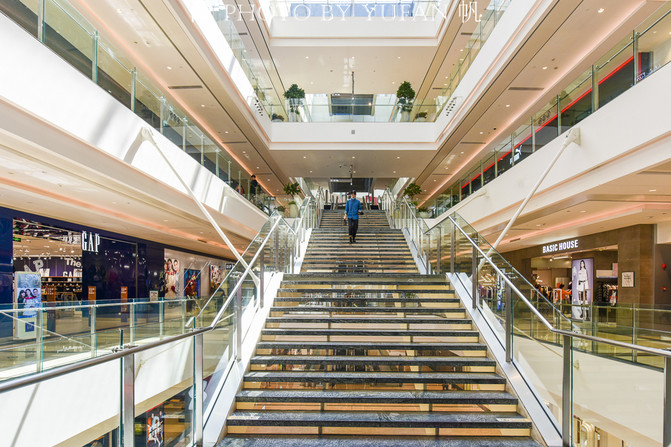
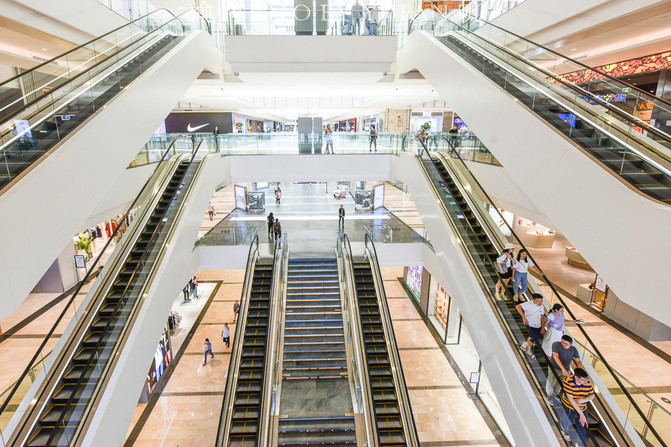
In order to facilitate the mutual access of tourists between Monument to the people's Liberation and Chaotianmen Square, Chongqing Raffles has specially built a 24-hour channel inside the shopping center, through which people can travel to and from Monument to the people's Liberation and Chaotianmen. Even at 3:00 in the morning, there is also a way of lighting up tourists. The 108 level staircase runs through the L1 to L4 floors of the shopping center, and the spacious staircase also combines the terrain characteristics of Chongqing's "climbing hills and ridges". During the trip, you can also experience the interesting terrain features of Chongqing and feel the spirit of Chongqing people's upward struggle.
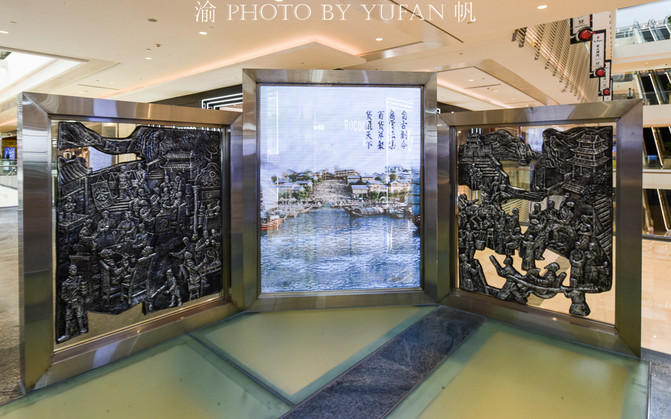
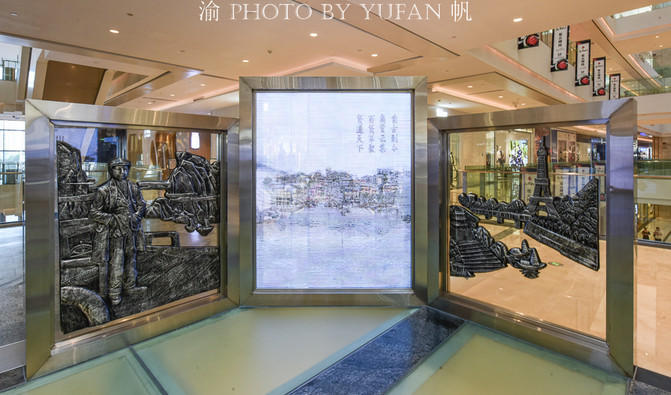
Along the 24-hour passage, there are many sculptures introducing Chongqing culture. The works use relief art combined with LED transparent screen technology to showcase the unique culture of Chongqing and Chaotianmen, including "Welcoming Officials and Receiving Saints", "Xiaoping Leaving the River", "Modern Commerce", "Folk Culture", "Chongqing Anti Japanese War", "Chuanjiang Shipping", "Chuanjiang Haozi", etc. As you walk slowly and savor them carefully, those who are interested can appreciate the thickness and brilliance of Chongqing culture.

On the 24-hour channel, you can also see the introduction of Chongqing Ancient City Gate, which is based on the folk song "Chongqing Song" in Chongqing. It clearly introduces the names and characteristics of 17 ancient city gates in Chongqing, including:
Chaotian Gate, Grand Pier, welcoming officials and saints (open); Cuiwei Gate, adorned with colorful satin, brightly colored (closed); Qiansimen, Huabaozi, Snow White as Silver (Open);
Hongya Gate, open wide boats, kill chickens and worship gods (closed); Linjiang Gate, Fecal Wharf, and Fertile Fields have a capital (opening); Tai'an Gate, Taiping Warehouse, Ji Gu Li Min (closed);
Tongyuan Gate, sound of gongs and drums, see the buried dead (open); Jintangmen, wooden coffin, neat in size (closed); South Gate, baskets of vegetables, gushing in (opening);
Phoenix Gate, turning on the river, herds of cattle and sheep (closed); Chu Qimen, herbal medicine help, cure all diseases (open); Jinzi Gate, facing directly, Zhentai Yamen (open);
Taiping Gate, Old Drum Tower, Time Reporting (Open); People and doors, artillery firing, General Ye on patrol (closed); Dingyuan Gate, Jiaochang Dam, wielding knives and sticks (closed);
West Water Gate, walking fast horses, as fast as the clouds (closed); Dongshimen, there is a square ancient well facing Zhenwu Mountain, where carp jump over the dragon gate.
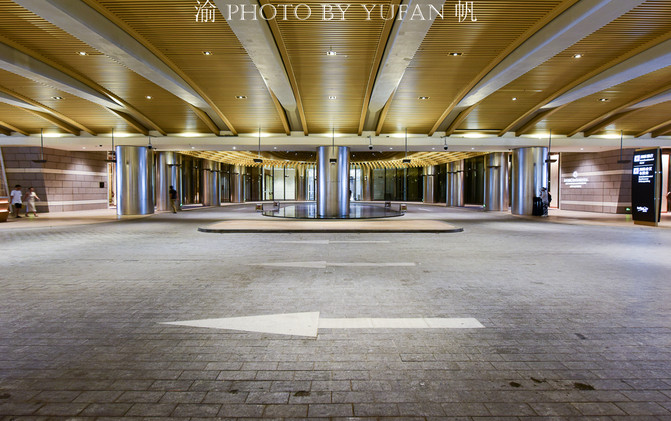
In order to facilitate the passage of citizens, Raffles City has specially built a passage connecting Changbin Road and Jiabin Road on the LG floor, and named it Jiesheng Street (a former old street in Chongqing that no longer exists). Because Chaotianmen used to be the gateway to welcoming officials and saints in Chongqing, Raffles City's construction of this road is not only about inheriting culture, but also has the meaning of customer first and treating tourists as emperors in Yufan's view, hence it is called Jiesheng.
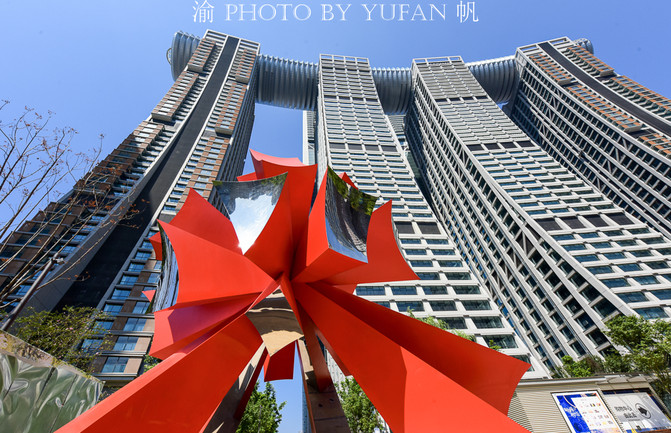
Above the Raffles commercial complex L5, there is a mountain city garden. The designer uses the atrium skylight and the roof garden space to create a beautiful music fountain, which integrates people and nature more closely. At the same time, tourists can also overlook the Chaotianmen Square and the beautiful scenery of the two rivers from a wide viewing platform. In addition, Raffles L1 is connected to Chaotianmen Square, and the mountain city garden is connected to Xinhua Road, which connects Monument to the people's Liberation. It can be said that the first floor is a square, and the fifth floor is a street, which explains the geographical characteristics of Chongqing as a mountain city.
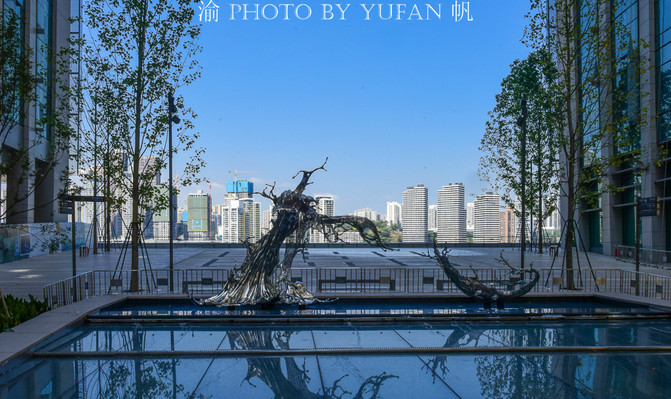
In the Shancheng Garden, we also see many themed sculptures, including one of the art sculptures "Language of Gathering" by Teacher Zheng Lu's "Dripping" series (at that time, he was cleaning the curtain wall and could not be photographed up close). It is said that the inspiration for the work came from the Tang Dynasty poet Bai Juyi's poem "Playing with Water Stop". In response to the theme of the confluence of the two rivers in Chongqing, the entire work is based on the concept of virtual and real blending in the text part, that is, we can see that the work is composed of two forms: solid and hollow. The two parts are seamlessly integrated and do not need to be used separately, in line with the natural wonders that appear at the confluence of the Yangtze River and Jialing River in Chongqing, with one clear and one muddy, and a clear distinction between the Wei River and the other.
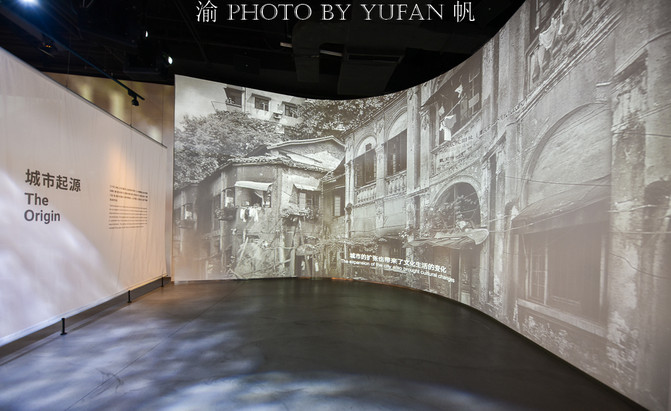
On the first floor of the first themed observation deck in China, the Exploration Warehouse Observation Deck, we first saw a cultural exhibition with the theme of "Tracing Chongqing". The entire exhibition hall is themed around "City Origins", "Discovering Chongqing", "Modern Times", "Gateway to the West", "Opening Eyes to the World" and "Participating in the Future", presenting Chongqing's history and culture in a concise, interesting and systematic manner. Here, we can have a good understanding and appreciation of Chongqing.

Here, you can see many rare cultural images and videos, which reproduce the urban development history of Chongqing from different historical perspectives. After browsing around, you cannot help but marvel at Chongqing, which has a long history of over 3000 years. Describing it as an "internet celebrity" is too one-sided. Although the Exploration Warehouse Observation Deck is a fee based commercial project, Yufan has to say that it is a meaningful themed exhibition that allows people to learn about Chongqing in a fun and engaging way, truly showcasing its potential.


For the convenience of citizens and tourists, Raffles City not only has the Chaotianmen bus hub and Chaotianmen subway station, but also on the L1 floor, we can see the airport city terminal building, high-speed rail city waiting hall, and tourist center under construction. Foreign tourists can use this as the starting point for their travel. Not only do buses directly reach Raffles City from the airport, but they can also check in (ticket checking) at the Raffles City terminal building (waiting hall) and be transported by a special car to the airport (high-speed rail station) for direct boarding (high-speed rail). This undoubtedly changes the inconvenience of Chaotianmen and beyond in people's minds in terms of time and space.
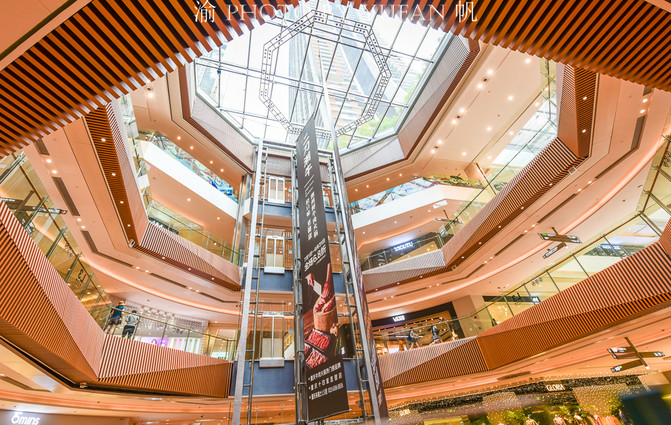
A Raffles City, half of Chongqing's history! Strolling through Chongqing Raffles City, as long as you pay a little attention, you can find Chongqing elements everywhere. For example, the courtyard design in the picture is like a blooming camellia (Chongqing city flower) in the eyes of Yufan. How can we not love such a landmark building that understands Chongqing and cares for tourists?
Previous Article:Shangqing Temple Storm (Part 1): The Glory and Epic of a City
